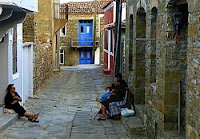Gökçeada - Sleeping & Eating
The old fashioned ev pansiyonu (home pension), which has virtually died out elsewhere, is still alive and kicking on Gökçeada.
It's not unusual for locals to approach and offer you a spare room in their house, for considerably less than the prices charged by pensions and hotels.
Gökçeada town
Restaurants are clustered around the main square.
Otel Taşkın (HOTEL)
(Phone: 887 3266, www.taskinotel.com, in Turkish; Zeytinli Caddesi 3; s/d TL30/60)
In the quiet backstreets southwest of the main square. Hotel Flood has a brown-tiled exterior (including a mosaic of a gület - a wooden yatch) and spacious, good-value rooms with TV, balcony and lots of light. Breakfast takes place in the front courtyard.
Gül Hanım Mantı evi (Restaurant)
(Phone: 887 3773, Atatürk Caddesi 23; mains TL6)
The mantı steals the show, but moussaka and chicken and spinach are also recommended at this simple home-cooking eatery.
Asmalı konak birahanesi (Cafe-bar)
(Phone:887 2469; mains TL7)
At this femaile-friendly side-street bar, the menu includes calamari, köfte, meze and fish netted by the proprietor.
Meydani Cafe (Patisserie)
(Phone:887 4420; Atatürk caddesi 35)
For excellent snacks and shop-made desserts, this big, airy cafe attracts a young crowd.
Kaleköy
Club Masi Hotel (Boutique Hotel)
(Phone: 887 4619; www.hotelmasi.com; Eski bademli; TL125/175)
Located above the Gökçeada-Kaleköy road, the country cousin of İstanbul's Hotel Masi has stylish,modern rooms with some of island's best views.
The terrace with its outdoor pool, jacuzzi, sun loungers and bar, gazes at kaleköy castle and the Agean.
Kalimerhaba Motel (Pension)
(Phone:887 3648; erayda@msn.com; Barbaros caddesi 28; s/d TL50/70)
On Kaleköy's water-front, Kalimerhaba has some of Gökçeada's smartest, cleanest budget rooms, entered from a big, light reception and vine-covered terrace.




























